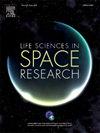Research on the effects of 15-day of head-down tilt bed rest on arterial hemodynamics and blood supply using Doppler ultrasound technology
IF 2.8
3区 生物学
Q2 ASTRONOMY & ASTROPHYSICS
引用次数: 0
Abstract
Prolonged exposure to microgravity would cause cardiovascular deconditioning in astronauts, leading to physiological discomfort, decreased cognitive function, and reduced work efficiency. This study aims to explore the hemodynamic effects of short-term -6° head-down tilt bed rest (HDBR) on the human circulatory system and the regulation mechanisms of blood supply to the neck and extremities. An HDBR experiment with a duration of 29 days was conducted. Doppler ultrasound was employed to quantify the blood flow spectra of the left carotid (CA), brachial (BA), radial (RA), and femoral (FA) arteries in 14 volunteers before and after HDBR. Blood flow velocity curves were obtained through edge contour extraction technology, to calculate hemodynamic parameters. After HDBR, the FA diameter significantly decreased by 0.2 mm. The resistance index (RI) of the RA, pulsatility index (PI) of the RA and PI of the FA significantly increased. The minute blood flow volume (MBF) in the CA, BA, RA, and FA significantly decreased. The proportion of total blood flow volume (PTBF) to the CA significantly increased by 4.8 %, while the PTBF to the FA significantly decreased by 4.1 %. After HDBR, the blood flow velocity, MBF, and total blood supply in the CA and extremities arteries decreased. Vasoconstriction and increased resistance in the FA led to a decreased blood supply ratio to the lower extremities and an increased ratio to the neck. This study provides a theoretical basis for the prevention of cardiovascular deconditioning and the establishment of targeted countermeasures, which are significant for enhancing astronauts' physical performance.
应用多普勒超声技术研究倒立床休息15天对动脉血流动力学和血供的影响
长期暴露在微重力环境下会导致宇航员心血管疾病,导致生理不适,认知功能下降,工作效率降低。本研究旨在探讨短期-6°头下倾斜卧床(HDBR)对人体循环系统的血液动力学影响及颈部和四肢血液供应的调节机制。进行为期29 d的HDBR试验。采用多普勒超声定量测定14名志愿者在HDBR前后左颈动脉(CA)、肱动脉(BA)、桡动脉(RA)和股动脉(FA)的血流谱。通过边缘轮廓提取技术获得血流速度曲线,计算血流动力学参数。HDBR后FA直径明显减小0.2 mm。RA的阻力指数(RI)、RA的搏动指数(PI)和FA的PI均显著升高。CA、BA、RA和FA的分钟血流量(MBF)显著降低。总血流量(PTBF)占CA的比例显著增加4.8%,而PTBF占FA的比例显著降低4.1%。HDBR后,CA和四肢动脉血流速度、MBF和总血供减少。FA血管收缩和阻力增加导致下肢血供比减少,颈部血供比增加。本研究为心血管疾病的预防和针对性对策的制定提供了理论依据,对提高航天员的体能水平具有重要意义。
本文章由计算机程序翻译,如有差异,请以英文原文为准。
求助全文
约1分钟内获得全文
求助全文
来源期刊

Life Sciences in Space Research
Agricultural and Biological Sciences-Agricultural and Biological Sciences (miscellaneous)
CiteScore
5.30
自引率
8.00%
发文量
69
期刊介绍:
Life Sciences in Space Research publishes high quality original research and review articles in areas previously covered by the Life Sciences section of COSPAR''s other society journal Advances in Space Research.
Life Sciences in Space Research features an editorial team of top scientists in the space radiation field and guarantees a fast turnaround time from submission to editorial decision.
 求助内容:
求助内容: 应助结果提醒方式:
应助结果提醒方式:


